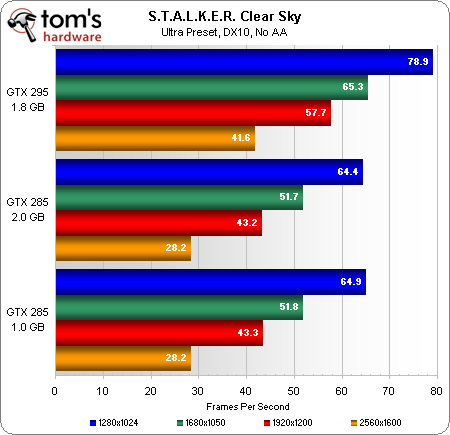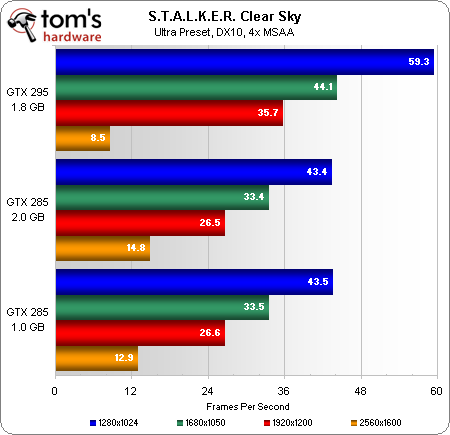GeForce GTX 285 Gets 2 GB: Gigabyte's GV-N285OC-2GI
Benchmark Results: S.T.A.L.K.E.R. Clear Sky
Water effects, vegetation and lighting set Clear Sky apart from many other first person shooters, but those added details can tax nearly any graphics system. We began our tests at the standalone-benchmark’s High preset, hoping to see smooth game play across all cards and resolutions.
Unfortunately, neither GeForce GTX 285 could smoothly play the game at 2560x1600, nor did increased graphics memory help. Both single-GPU cards also suffered at 1920x1200 under the “SunShafts” test, stalling at a few points along the test map.
Moving up to the Ultra quality preset dropped both GTX 285 models equally, while the GTX 295 maintains its lead. Yet, not even the GeForce GTX 295 could pass the “SunShafts” test, its 25.3 FPS result dragging the average down to 41.6 FPS.
Add 4x AA to the “Ultra” quality preset and you’re lucky if even the dual-GPU GTX 295 can play every scenario at a meager 1280x1024 resolution, though the average of all tests doesn’t reveal that problem. Notice that the GTX 285 finally edges ahead at 2560x1600, though stutters and stalls prevent the game from being playable at this setting.
Get Tom's Hardware's best news and in-depth reviews, straight to your inbox.
Current page: Benchmark Results: S.T.A.L.K.E.R. Clear Sky
Prev Page Benchmark Results: Left 4 Dead Next Page Benchmark Results: World In Conflict-
twisted politiks ive had EVGA's GTX 285 for about two months now, nothing new in the memory departmentReply -
rambo117 wow... that was quite pointless, i was really expecting a good article but it was the same numbers basically, why not just have a single page with the average gains with 2gb vs 1gb (which was completely nonexistent anyways)Reply
-
astrodudepsu Well, all I can say is good try. Not some of your best work, but worth exploring nonetheless.Reply -
Crashman astrodudepsuWell, all I can say is good try. Not some of your best work, but worth exploring nonetheless.Reply
Tom's Hardware was hoping to find more 2560x1600 scenarios where the 2GB advantage would play out. When very few advantages were found, Tom's did the honest thing and published the numbers anyway.
I think you can take a lot from this article. I just spoke to a guy who asked "2GB or water cooling?" when looking at cards of the same price. He has a powerful water cooling loop, so the answer was easy. -
one-shot I think it is a great article. Too often people approach me thinking a larger frame buffer means extra performance. Actually, just recently a co-worker wanted to get a GTX 285 with 2GB of VRAM. Great article, keep it up!Reply -
SpadeM Just a quick question: Since the GTX285 is a high range card, those the same "1GB is enough" rule apply to mid range/low end cards?Reply
PS: I'm thinking slower GPU might benefit from more memory -
astrodudepsu CrashmanTom's Hardware was hoping to find more 2560x1600 scenarios where the 2GB advantage would play out. When very few advantages were found, Tom's did the honest thing and published the numbers anyway.Reply
Which is why I said it was worth exploring. I realize you wouldn't do all this work and NOT publish your results, as mundane as they may be. -
rambo117 it was quite informative and worth exploring like astrodude said. just wish that it was a little more 'exciting'.. idk, maybe an sli 2gb vs 1gb will prove to be possibley more interesting.Reply -
Hellbound If a card is going to cost $350-$400, and perform as much as %50 less than the car that costs $500....get the $500 card. You are already spending an insane amount for a card, might as well go all the way. As for me, I'm waiting for the DX11 cards to come out.Reply -
Crashman rambo117it was quite informative and worth exploring like astrodude said. just wish that it was a little more 'exciting'.. idk, maybe an sli 2gb vs 1gb will prove to be possibley more interesting.Reply
Three-way would have been best, but there's just not enough samples to go around.



